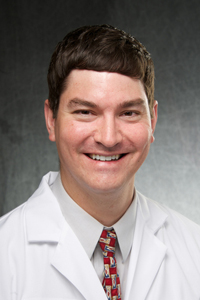First Successful Organ Transplant
Breaking the Barrier of Organ Rejection
Dr. John Keech Interview
"In 1983, a drug called cyclosporine was available and that is largely credited with the increase and expansion of transplantation."
- Dr. John Keech, Cardiothoracic Surgeon

Dr. John Keech of UIHC
Email Interview
What is your main role at the University of Iowa Hospitals? "I am a general thoracic surgeon and lung transplant surgeon, performing surgeries of the lungs, esophagus, and chest. I am also in charge of the educational training program for trainees learning to become cardiothoracic surgeons."
How long have you been a surgeon? "12 years."
Why did you want to become a surgeon? "I actually wanted to be a jazz musician coming out of high school believe it or not! In college, I first wanted to become a doctor which came from a desire to help people and experiences working and volunteering in medical areas. My desire to become a surgeon started when I had a weekend job in college working in the operating rooms at the University of Wisconsin; it wasn’t a very important job, but I was able to see the life of surgeons and observe some surgeries and I was hooked. I entered medical school knowing I was going to be a surgeon."
What kinds of transplants have you performed? "I perform lung transplants in my current job, but during my training I have performed liver, kidney and heart transplants too."
How has transplant surgery changed over the years? "A lot has changed! The first human lung transplant was in 1963 but did not survive long, and it wasn’t until 1983, (20 years later!) that the first long term survivor was achieved. This probably had a lot to do with advances in immunosuppression; our bodies will attack and destroy transplanted organs unless our immune systems are suppressed. In 1983, a drug called cyclosporine was available and that is largely credited with the increase and expansion of transplantation."
"Also, the way we do the transplants has changed. The first pioneers tried to just replace one lung, then a team created the double lung transplant; initially they tried to put both lungs in at the same time just by sewing the trachea (windpipe) with both lungs attached on the donor to the recipient. This didn't go well and the modern/current version was created where we remove one bad lung and put one good one in, then take the second bad lung out and put the second new lung in. We call the bilateral sequential lung transplant. This is the operation I currently perform on more than 90% of patients."
"Another difference is that newer immunosuppression drugs have been developed (too many to mention here) so our ability to control the immune system has vastly increased."
"The indications for why we transplant has also changed over time. Early on the most common indications for transplant were COPD (chronic obstructive pulmonary disease)/emphysema, cystic fibrosis, pulmonary fibrosis (stiff lungs), and several others. Some changes we have seen are that COVID-damaged lungs now account for about 10% of transplants, and cystic fibrosis is nearly non-existent because of a revolutionary drug therapy for that disease."
"I would also say that the team approach to lung transplant care has evolved greatly and we now have a large group of experts taking care of these complex patients."
"Survival has also improved after lung transplant where 1-year survival is now around 85% nationally (ours is 91% at UIHC), 54% at 5 years (ours is 60%). The 1 and 5 year survival were 75% and 40% in the 1990s."
What, if any, new techniques or procedures are on the horizon for transplant surgery? "These changes happen more slowly, and I'm not sure I envision a completely new procedure in the next few decades. One of the changes taking place is the following: Ex-vivo Lung Perfusion (aka EVLP). This is a very cool technology! The idea starts with the fact that not all organ donors have good lungs; some are in bad shape. EVLP was created with the idea that maybe we could fix these lungs OUTSIDE the human body, hooked up to a machine, and then when they lungs recover and are now good, they could be transplanted. This is currently happening on a small scale and will only increase and certainly increase the number of lungs that are good enough to transplant. The other change is something called ECMO (extra corporeal membrane oxygenation); this is technology that allows someone's blood to diverted out of their body and run through a machine where oxygen can be put in and carbon dioxide removed. This tech has been around for a long time but keeps advancing to the point where people whose lungs are failing can be kept alive for a longer and longer time while waiting for a transplant."